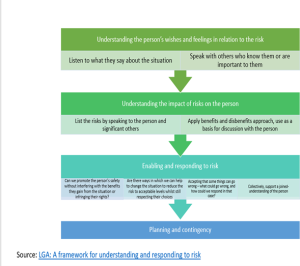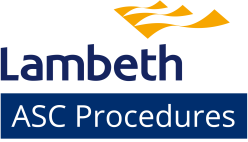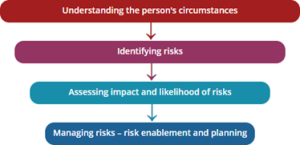Applicable to all Adult Social Care Teams.
Approval date: 19/03/2025.
CONTENTS
1. Context
In Lambeth Adult Social Care, we acknowledge that managing risk is an inherent part of adult social care practice and this Risk Rating Framework is a tool that supports our overarching Risk Management Approach.
2. Introduction
Managing demand is the process of managing and prioritising referrals received and work awaiting action to ensure that service users and potential service users are given timely, appropriate and good quality services.
Given the demand on services and the types of situations that are presented to us where at times, urgent response are required, it is essential that work is prioritised in order to mitigate risks.
Workload management and decision- making requires the ability to calculate the degree of urgency and the risk of inaction or priority when services or intervention are potentially required.
Risk and risk management (Source: Risk assessment process and key points to risk identification in virtual interactions, SCIE)
Risk is part of everyday life. Risk management is not about trying to eliminate risk but managing risks to maximise people’s choice and control over their lives. This includes positive risk taking. Risk is:
- the probability that an event will occur with beneficial or harmful outcomes for a particular person or others with whom they come into contact;
- a product of the likelihood that an event will occur and the impact that it will have if it does.
This Risk Assessment diagram (Source: SCIE) outlines the four key elements that need to be considered as part of workload management and should be considered in the context of impact and likelihood of the risk occurring.
(Click on the image to enlarge it)
3. In Practice
The risk rating framework has been developed to assist practitioners in assessing the seriousness and level of risk associated with the pieces of work incoming and being held in the team, to assist with their decision-making at both the stage of receiving the piece of work/ referral and at the point of allocation of the piece of work / action required, and to support with prioritising and managing demand in relation to this.
This framework is not intended to replace professional judgement, it seeks to provide consistency across the teams in relation to decision- making and resource allocation.
4. The Framework
This framework sets out a prioritisation of work based on risk and utilises simple RAG ratings to do this.
4.1 The RAG rating should be reviewed at regular daily or weekly intervals
Information gathering enables us to understand the person’s circumstances. Information can be gathered from a range of sources including the person themselves, a family member / friend / advocate, a professional who provides a service to them (e.g. GP), reviewing Mosaic, Hospital records, LCR / HIE, EPJs. This may help to inform or reduce risk as more information is gathered.
The purpose of the framework is to enable the decision maker to determine what action is needed, with a view that the action(s) taken will mitigate or reduce the risk.
Currently RAG / priority ratings are captured in the free text notes alongside the relevant workflow step/ piece of work. This note can be amended/ updated.
RAG / Priority ratings should be reviewed frequently to support management of risk and prioritisation of workload allocations. Performance dashboards to support reporting and management of waiting lists will support teams to have oversight on current demand and waiting times.
This framework should be supported with good communication between teams to promote the flow of work and support prioritisation. In situations where an urgent or Red RAG response is indicated, a telephone call or face to face discussion between relevant managers is needed to ensure that the work or intervention is picked up and responded to in a timely way.
| RAG rating | Type of concern / risk | Timescale |
| Urgent | The adult or carer requires an immediate response due to risk or escalating risk
These situations typically receive a response from @Home or iCAS. In these cases an urgent care and support plan is completed to put services in place quickly. |
Same day / next day |
| Red (priority 1) | The adult (or carer) is experiencing risk or change in circumstance where prioritisation for intervention/assessment is required | Action / outcome within 1 – 2 weeks |
| Amber (priority 2) | The adult (or carer) is experiencing deterioration in their independence and requires intervention / assessment in order to address or reduce the risks associated with this deterioration | Action / outcome within 2 – 4 weeks |
| Green (priority 3) | There are low level concerns of vulnerability or risks which, if not addressed, may lead to poor outcomes or an impact on the person’s wellbeing. | Action / outcome within 4- 6 weeks |
Appendix 1: Source LGA: A framework for understanding and responding to risk
Source: LGA: A framework for understanding and responding to risk
Click on the image to enlarge it)

Appendix 2: Additional Resources
| MCA guidance | What is the Mental Capacity Act? (Lambeth Safeguarding Adults Board) |
| Complex Case Framework | Complex Case Pathway Framework (Lambeth Safeguarding Adults Board) – opens as a pdf |



